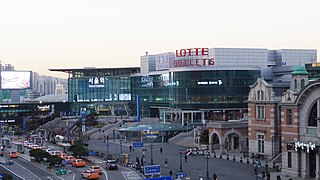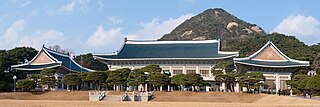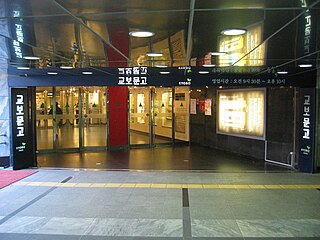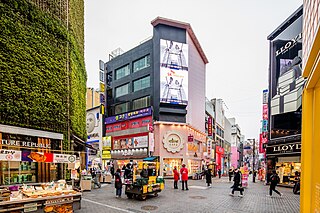
A square is an open public space used for various activities. Squares are not necessarily a true geometric square. Most squares are hardscapes suitable for open markets, concerts, political rallies, and other events that require firm ground.

The N Seoul Tower, officially the YTN Seoul Tower and commonly known as Namsan Tower or Seoul Tower, is a communication and observation tower located on Namsan Mountain in central Seoul, South Korea. The 236-meter (774 ft)-tall tower marks the second highest point in Seoul and is considered a local landmark.

Gyeongbokgung, also known as Gyeongbokgung Palace, was the main royal palace of the Joseon dynasty. Built in 1395, it is located in northern Seoul, South Korea. The largest of the Five Grand Palaces built by the Joseon dynasty, Gyeongbokgung served as the home of the royal family and the seat of government.

Seoul Station (Korean: 서울역) is a major railway station in Seoul, the capital of South Korea. The station is served by the Korail Intercity Lines and the commuter trains of the Seoul Metropolitan Subway.

Cheong Wa Dae, also known as the Blue House in English, is a public park that formerly served as the presidential residence and the diplomatic reception halls of South Korea from 1948 to 2022. It is located in the Jongno district of the South Korean capital Seoul.

Sejong Center for the Performing Arts (Korean: 세종문화회관) is the largest arts and cultural complex in Seoul, South Korea. It has an interior area of 53,202m². It is situated in the center of the capital, on Sejongno, a main road that cuts through the capital city of the Joseon Dynasty. The center took 4 years to complete, opening in 1978. It was "built as a cultural center for Seoulites". It currently contains one of the biggest pipe organs in Asia.

Sejongno (Korean: 세종로), also known as Sejong-daero, is a street that runs through Jongno-gu in downtown Seoul. It is named after King Sejong the Great of Joseon. The street is 600 meters in length, but due to its central location it is of great symbolic importance. It points north to Gwanaksan and Bukhansan (Mountains), and the Joseon Dynasty palace, Gyeongbokgung. It is also of historical significance as the location for royal administrative buildings and features statues of the Admiral Yi Sun-sin of Joseon Dynasty and King Sejong the Great of Joseon.

Kyobo Book Centre is the largest bookstore chain in South Korea. It has ten stores in seven cities, with the flagship Main Store, or Gwanghwamun-jeom in Seoul, which is located in the basement of the Kyobo Building, at 1 Jong-ro, Jongno-gu in Seoul's central business district.

Gwanghwamun Station (Korean: 광화문역) is a station on the Seoul Subway Line 5 in South Korea. It is not the closest subway station to the actual gate of Gwanghwamun, which it is named after. It is located next to the U.S. Embassy in Seoul.

Myeong-dong is a dong (neighborhood) in Jung District, Seoul, South Korea between Chungmu-ro, Eulji-ro, and Namdaemun-ro.

Lee Myung-bak often referred to by his initials MB, is a South Korean businessman and former politician who served as 10th president of South Korea from 2008 to 2013. Before his presidency, he was the CEO of Hyundai Engineering and Construction, and the mayor of Seoul from 2002 to 2006.

Gwanghwamun is the main and largest gate of Gyeongbok Palace, in Jongno-gu, Seoul, South Korea. It is located at a three-way intersection at the northern end of Sejongno. As a landmark and symbol of Seoul's long history as the capital city during the Joseon Dynasty, the gate has gone through multiple periods of destruction and disrepair. The most recent large-scale restoration work on the gate was finished and it was opened to the public on August 15, 2010.

Express Bus Terminal Station is a station on the Seoul Subway Line 3, Line 7, and Line 9. The stations are located in the Greater Gangnam Area, Banpo-dong, Seocho District, Seoul, Korea.

Ilmin Museum of Art is a private art museum of South Korea, located on Sejongno street in Jongno-gu, a central district of Seoul, known for exhibiting mainly Korean art. The museum was established and run by the Ilmin Cultural Foundation (Korean: 일민문화재단), a non-profit organization founded in 1994 in memory of Kim Sang-man, former president of Dong-A Ilbo, one of the major newspaper companies of South Korea. Kim devoted his entire life to developing Korean journalism and promoting Korean culture. The museum is named after his pen name, "Ilmin".

Kim Gyu-ri, is a South Korean actress best known for the film Portrait of a Beauty.
United States beef imports in South Korea made up a $504 million industry for the American beef industry in 2010. The import of U.S. beef was banned in 2003 in South Korea and in other nations after a case of bovine spongiform encephalopathy was discovered in the United States. At the time, South Korea was the third-largest purchaser of U.S. beef exports, with an estimated market value of $815 million. After a number of failed attempts at reopening the Korean market, imports finally resumed in July 2008 leading to the massive 2008 US beef protest in South Korea. In 2010, South Korea again became the world's third largest U.S. beef importer.

Gwanghwamun Square is a public square on Sejongno, Jongno-gu, Seoul, South Korea. Serving as a public space and at times road for centuries of Korean history, it is also historically significant as the location of royal administrative buildings, known as Yukjo-geori or Street of Six Ministries; and features statues of Admiral Yi Sun-sin of Joseon Dynasty and King Sejong the Great of Joseon.
The following is a timeline of the history of the city of Seoul, South Korea.

The statue of Admiral Yi Sun-sin is located at the street Sejongno, Gwanghwamun Plaza, Seoul, South Korea. It is dedicated to the 16th-century Korean war hero, admiral Yi Sun-sin. It is considered one of Seoul's major landmarks and has been called "one of the most important instances of Korean public art".

Statue of King Sejong is located at the Sejongno, Gwanghwamun Plaza in Downtown Seoul, South Korea. It is dedicated to the 15th century Korean monarch, Sejong the Great, the fourth king of Joseon dynasty and one of Korea's most famous historical figures. The statue is considered one of Seoul's major landmarks. Unveiled in 2009, it has been called "South Korea's most iconic statue."



















